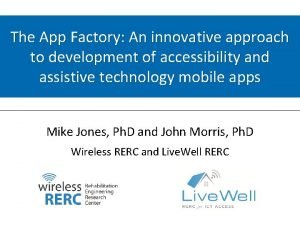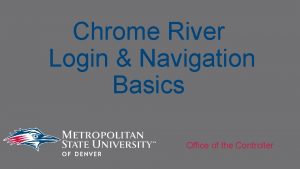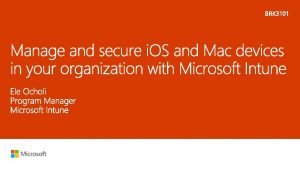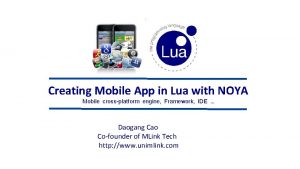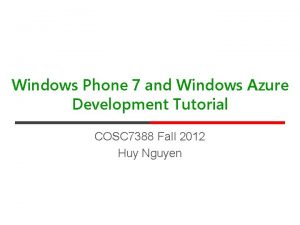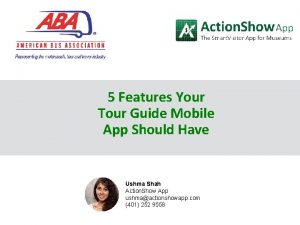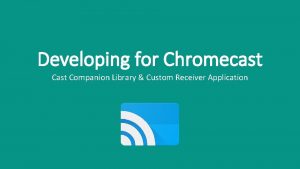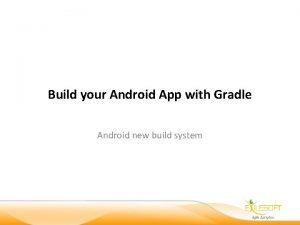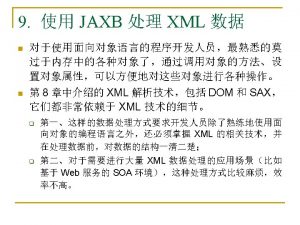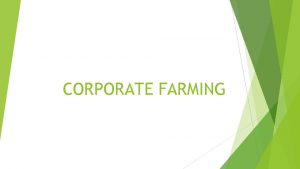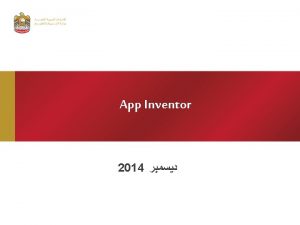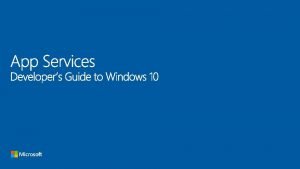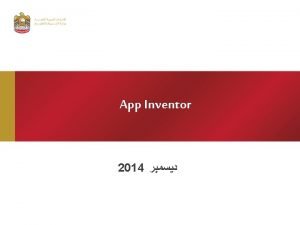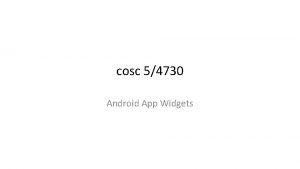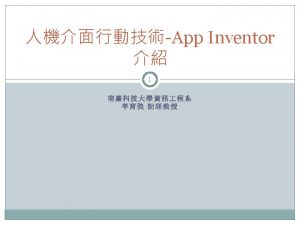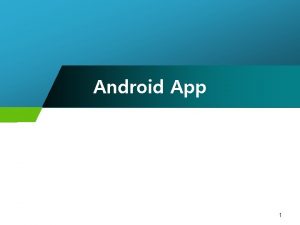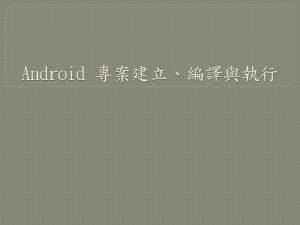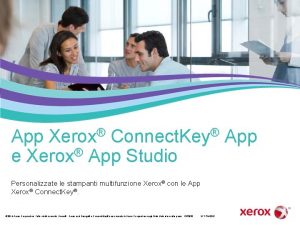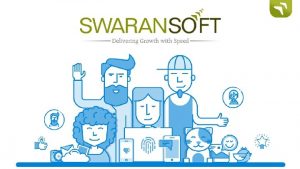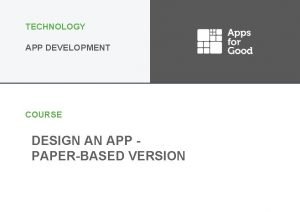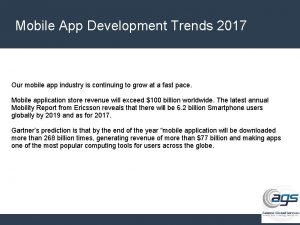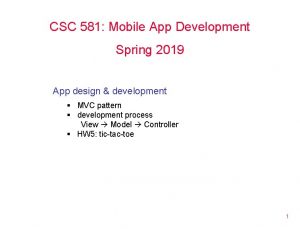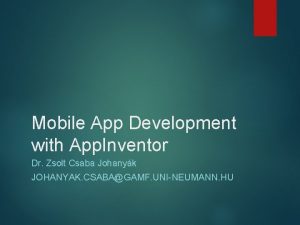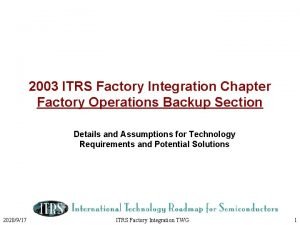The App Factory An innovative approach to development























- Slides: 23

The App Factory: An innovative approach to development of accessibility and assistive technology mobile apps Mike Jones, Ph. D and John Morris, Ph. D Wireless RERC and Live. Well RERC

Presentation Overview 1. Challenges of tech development and transfer in an era of rapid advancement 2. Background of the App Factory 3. The App Factory process and history to date 4. Examples: • Pay for performance: Contracts and milestones • App Factory products (videos) 2

Wireless RERC • Founded in 2001 • Partnership between Georgia Tech & Shepherd Center • Mission of the Wireless RERC – • promote access to and use of wireless technologies by people with disabilities • encourage adoption of Universal Design approaches in future generations of wireless technologies. 3

Live. Well RERC • Founded in 2015 • Partnership between Duke University, Shepherd Center, and Northeastern University • Mission of the Live. Well RERC – • promote access to existing and emerging ICT for people with disabilities • develop and validate ICT applications to improve the capacity for independent living and community participation 4

The challenge • Forecasting technology developments and changing user needs over a multiyear funding cycle • Advent of application programming interfaces (APIs) for mobile platforms provides opportunity for rapid development of specialized AT solutions • Priorities of “academic” developers 5

The App Factory model • Two primary goals: 1) Bring highly-talented and prolific private-sector developers into the process of designing apps that address AT user needs 2) Establish a “pay for performance” mechanism to encourage successful commercialization of useful apps. Complementary objective: create a model for consumer engagement in the development process 6

App Factory criteria • App must address an important accessibility or assistive technology need • App is unlikely to be developed in the commercial marketplace (e. g. , “orphan” app) • App is technically feasible • Projected “lifetime” or impact of the app justifies the investment • App does not duplicate existing apps 7

App Factory proposal • Must demonstrate: – Need: importance of app for consumer – App doesn’t already exist – Feasible with available tech, time and money – Developer has the technical capability to build it – Efforts to make sure: • app is usable by consumer • consumers like it • it will have lasting impact 8

Live. Well RERC – App Factory (D 2 -A) Tech Transfer Process 1. Identify App Needs • User research (R 1/R 2) • Tech/policy watch (D 1) • Input from subject matter experts 5. App Launch & Maintenance 2. Solicit App Proposals • Publish app in marketplace • Track use, satisfaction, and impact • Maintain app (3 years) • Justification of needs • Competitive landscape • Technical feasibility and capability • Budget, timeline, and milestones • Plan for maintenance & follow up 4. Project Management • Award notification and contract execution • Project monitoring • Payment against milestones 3. App Project Selection • Review by App Council and subject matter experts • Priority ranking • Negotiation of budget and milestones 9

App Factory outputs first 3 years • Funded 4 -6 app projects a year • Budgets range between $5, 000 -$30, 000 • Roughly 70/30 split of private-sector vs. academic developers • 11 of 16 funded projects produced commercially available apps • 7 accessibility apps; 9 assistive apps • Over 600, 000 downloads in 4 years 10

11

App Factory outputs - Last 2 years Wireless RERC • Funded 9 app projects (8 completed) – Hearing, dexterity, cognitive, developmental disabilities – Budget range: $12, 000 - $24, 500 Live. Well RERC • Year 1 – Funded 3 app projects: – 2 cognitive assist, 1 manual-dexterity rehab • Year 2 – External proposals currently under review 12

Advantages of this approach • Rapid development and deployment • Leverages existing app marketplaces • Pay for performance provides incentives to get the product to market • Encourages development of “orphan” apps • Consumer engagement improves relevance and impact of apps • Secondary dispersal of $ a model for others? 13

Potential limitations of approach • Some apps less successful in terms of downloads (but that may be okay) • Limited shelf-life of apps in general • Notable differences in success of privatesector vs. academic developers • Ability to contract with multiple vendors can be a challenge for some 14

Challenges measuring impact • Downloads do not indicate use – average monthly users or average monthly use time might be better indicators, but still indirect measures • Potential user base may be small – downloads may be relatively few, but impact could be high • For projects developed by external teams, the RERC must ask each team individually to provide download data 15

Pay for performance – Contracts and milestones Zyro. Math by Zyrobotics (Contract value = $17, 620) Integrated switch-accessible runner-game for children that keeps them motivated while learning basic math. • Milestone 1: $5000 - Completion of user interface development • Milestone 2: $4000 - Development of full functionality of app, including: a) b) a tool for automatic assessment of each child’s motor abilities (with respect to interaction) for creation of a near-optimal set of parameters to configure the app's settings, and a graphical interface for parents, clinicians, and teachers that provides longterm reporting on the child’s progress and performance • Milestone 3: $4000 - Completion of user testing & usability fixes • Milestone 4: $4620 - Product launch and availability on both Android and i. OS operating systems 16

Pay for performance – Contracts and milestones Smart Steps enhancements (Contract value=$23, 475) Mobile application for individuals with cognitive disabilities to reduce anxiety, solve everyday problems, and increase independence using decision trees and personalized backup support. • Milestone 1: $7500 - Add private and public decision tree database; License management for groups; admin portal to associate files so that trees can be assigned and to buy a set of licenses; ability to store cell numbers for texts messaging • Milestone 2: $7500 –Read aloud button in the app; customize colors for the text boxes and tips; enhance login workflow; payment portal for credit card processing • Milestone 3: $8475 – Beta testing and release: availability through Google Play, Amazon apps 17

Examples of App Factory Outputs Tetra Alarm Chillaxing Software Pow!r Mount Blue. Sky Designs Breathe. Well on Watch Shepherd Center 18

Examples of App Factory Outputs Video coming soon! Tetra Alarm Chillaxing Software Tetra Alarm allows you to easily set reminders for periodic, daily events. Alarms are easy to set and intuitive. • Multiple alarms can be set to signal a user to complete necessary tasks throughout their day. • Alarms can be signaled by various methods – audible, visual or tactile – and can be customized to attract your keenest senses. 19

Examples of App Factory Outputs https: //youtu. be/q. K 0 Ae 9 s. A 3 ek Pow!r Mount Blue. Sky Designs The Pow!r Mount App controls the Pow!r Mount motorized mounting system developed by Blue. Sky Designs. • Pow!r Mount is a configurable system of motorized joints that includes dual powered arms, single powered arm, or hybrid system with a single manual and single motorized arm • The app is accessible via touch or switched access (single switch or 2 -switch) • App allows pre-set target positions or custom adjustment • Mounting system accommodates tablets, smartphones, etc. 20

Examples of App Factory Outputs Video coming soon! Breathe. Well on Watch Shepherd Center Android Wear smart watch app to assist individuals with mild traumatic brain injury (m. TBI) and posttraumatic stress disorder (PTSD) to manage stress through diaphragmatic breathing. • Smart watch platform allows for quicker access and more discreet use of a breathing therapy aid than is currently provided by apps running on smartphones and tablets. 21

App Factory RFP (currently closed) http: //www. livewellrerc. org/2016 appfactoryrfp 22

Thank you! Contacts: Mike Jones – mike_jones@shepherd. org John Morris – john_morris@shepherd. org The Wireless RERC and Live. Well RERC are funded by the National Institute on Disability, Independent Living and Rehabilitation Research (NIDILRR) in the U. S. Department of Health and Human Services (grant numbers 90 RE 5007 -01 -00 and 90 RE 5023, respectively). All opinions expressed in this presentation and workshop belong to the presenters, and do not necessarily reflect those of NIDILRR or the Department of Health and Human Services. 23
 The impact factory
The impact factory Mobile app factory
Mobile app factory Chrome river msu
Chrome river msu App on apple app store user
App on apple app store user Virtual circuits and datagram networks
Virtual circuits and datagram networks Theoretical models of counseling
Theoretical models of counseling What is preliminary and fine grain screening?
What is preliminary and fine grain screening? Approach approach conflict
Approach approach conflict Cognitive approach vs behavioral approach
Cognitive approach vs behavioral approach Study approach meaning
Study approach meaning Traditional approach to system development
Traditional approach to system development Tony wagner's seven survival skills
Tony wagner's seven survival skills Mobility landscape in mobile app development
Mobility landscape in mobile app development Lua mobile app development
Lua mobile app development Windows phone app development tutorial
Windows phone app development tutorial Audio tour guide app development
Audio tour guide app development Chromecast custom receiver
Chromecast custom receiver Chatbot development for auto dealer app
Chatbot development for auto dealer app Gradle android app development
Gradle android app development Hình ảnh bộ gõ cơ thể búng tay
Hình ảnh bộ gõ cơ thể búng tay Slidetodoc
Slidetodoc Bổ thể
Bổ thể Tỉ lệ cơ thể trẻ em
Tỉ lệ cơ thể trẻ em Voi kéo gỗ như thế nào
Voi kéo gỗ như thế nào

